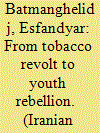| Srl | Item |
| 1 |
ID:
143587


|
|
|
|
|
| Summary/Abstract |
Focusing on the cultural influence of the cigarette, this paper synthesizes a wide range of evidence to argue that the cigarette was a fundamental primer for Iran's encounter with modernity, especially as understood in the context of western influence. Applying the dramaturgical theories of sociologist Erving Goffman, it is argued that the cigarette is an instantiation of the “sign-equipment” of modernization used to refashion the identity and subjectivity of Iranian men and women. This refashioning has occurred in three distinct periods. In the first period (1860–1930), cigarette smoking was a habit adopted by the Persian elite in an attempt to mediate the encounter with European colonial figures. In the second period (1930–70), cigarettes were leveraged by Iranians who wished to be seen as upwardly mobile. In the final and contemporary period (1970–present), cigarettes have become ubiquitous among the adult population, but smoking itself has become the act of youth rebellion as experimentation occurs at increasingly young ages.
|
|
|
|
|
|
|
|
|
|
|
|
|
|
|
|
| 2 |
ID:
132106


|
|
|
|
|
| Publication |
2014.
|
| Summary/Abstract |
The major foreign concessions granted in the reign of Nasser al-Din Shah Qajar have received considerable attention, none more so than the Tobacco Rebellion, which is generally viewed as a watershed event in the awakening of political consciousness in Iran. Although mentioned in most of the published material on the precedents of the Constitutional Revolution of 1906, a revised narrative of the tobacco rebellion is overdue. This paper fills the gaps and revises some of the widely held assumptions on the forces that unleashed a nationwide movement that almost brought down the Qajar dynasty. The emphasis is on the incendiary protests in Tabriz and the largely neglected role of Hajj Kazem Malek-al-Tojjar. This article, which is the fifth of a series by the author on the two Malek-al-tojjar-e mamalek-e mahrusa of the Qajar era, questions the authorship of the fatwa (hokm) and re-assesses the motivation for its hasty proclamation and dissemination. In other words, were the "sensation-seekers" the heroes of reform or is there a neglected version to extricate from the truths and half-truths propounded about this watershed event?
|
|
|
|
|
|
|
|
|
|
|
|
|
|
|
|